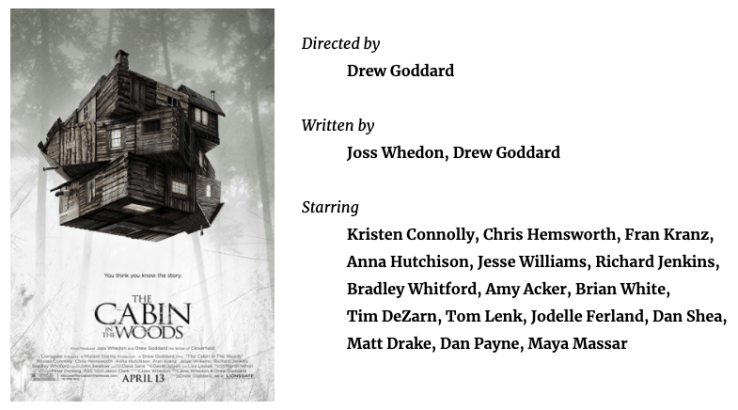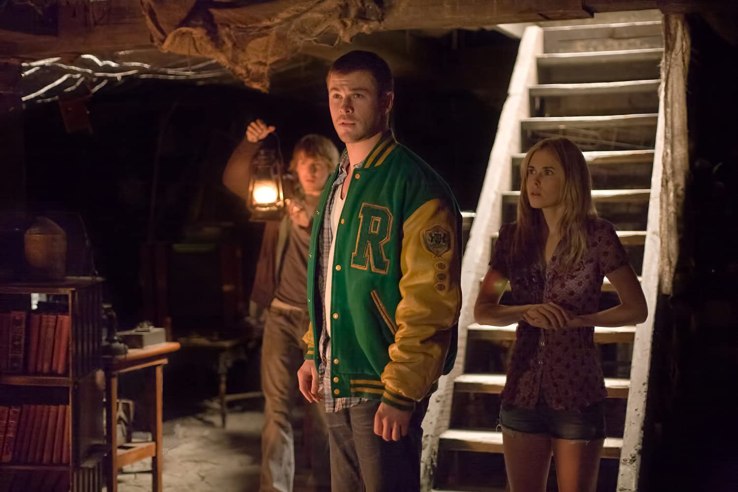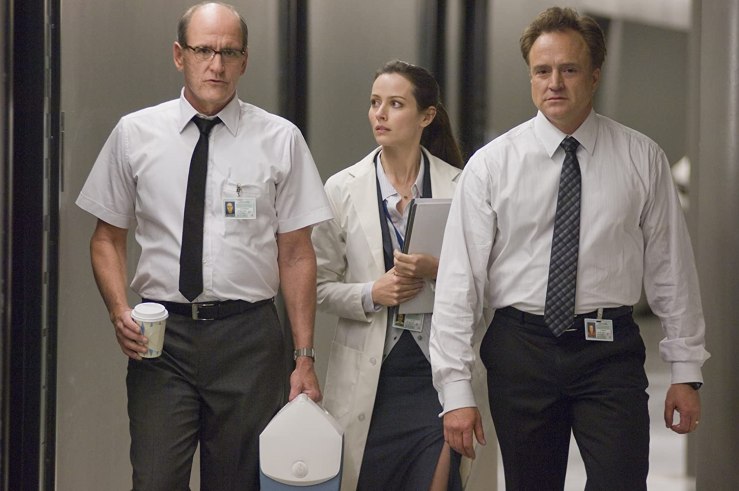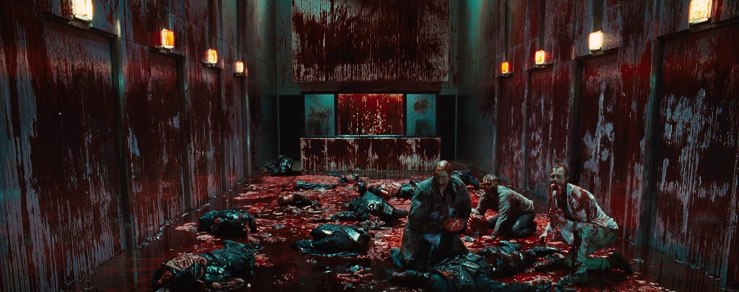
Spoofs—or parodies, take-offs, sendups, whatever you want to call them—have got to be some of the most inherently appealing movies out there. It’s a rare viewer who truly dislikes the Mel Brooks and Monty Python classics, and even the lesser entries are much easier to enjoy than mediocre movies of other kinds. Even a parody that’s actively bad, like the Family Guy Star Wars spoof Blue Harvest, can often pull off a memorably inspired moment (that one involves the cantina band, and it’s hilarious). Humor will always have a certain hard-wired appeal, and I think we’re especially drawn to parody because it finds an entertaining way to keep genre film honest, calling out clichés, hackneyed elements, and all the other bits of artistic laziness that test the patience of even the most devoted cinema lovers. The irony is that more often than not, movie spoofs can fall prey to the same tendencies. And to an extent, I get it; comedically, there’s a lot of low-hanging fruit to go for, and even the silliest movies are still crowded, frightfully expensive enterprises. Originality and creativity are financially risky, and, in such a collaborative art form, difficult to achieve even under favorable circumstances. So it feels like a rare and special gift when a spoof is not just funny and incisive, but a great movie in its own right, managing to work on some of the same terms as the movies it’s making fun of. (The Princess Bride, for example, is ridiculous, but often as genuinely affecting as the stories it pokes fun at. And is there anyone on Earth who doesn’t like The Princess Bride?) This is the sublime state of parody that we find in Drew Goddard’s The Cabin in the Woods, a modestly scaled but enormously clever movie from 2011[i] that’s equal parts love letter to and trenchant critique of the slasher/horror genre.
It’s a confident directorial debut for Goddard, who had spent the 2000s writing for TV and movies with a similar focus on science fiction and the supernatural, from Buffy the Vampire Slayer, Angel, Alias, and Lost to Cloverfield in 2008. But while Goddard certainly does the heavy lifting in bringing the story to the screen, The Cabin in the Woods is best understood as a team effort from him and Joss Whedon, his co-writer and longtime creative kinsman. From Buffy to Firefly, Agents of S.H.I.E.L.D., Serenity and the first two Avengers installments, Whedon has had one of the more influential TV and film careers of the 21st century, with a distinctive ability to infuse effective sci-fi action and suspense with a witty, knowing sense of humor.
The Cabin in the Woods is a classic expression of this aesthetic sensibility that Whedon and Goddard share. They’re not content to simply lampoon horror tropes through ridiculous exaggeration; they also add the novel element of a secret government agency managing the whole slasher experience—a comedic conceit that proves surprisingly durable, consistently delivering laughs while avoiding the cheap and easy silliness of the Scary Movie franchise, for example. Some critics complain, not unreasonably, that this prevents the movie from managing the artistic coup of being truly unsettling even as it spoofs the genre, but most also recognize that this probably wasn’t the filmmakers’ intention. Dana Stevens describes it best as a “horror-inflected black comedy…a playful riff on the ‘last girl’ slasher movie, in which a group of young people in isolation are hunted down one by one by a murderous, often supernatural entity who tends to save the pretty virgin for last.”[ii]

Whedon and Goddard know their stuff, and they manage to squeeze a prodigious amount of comic twists and in-jokes into the movie’s lean 90-minute runtime. But the great thing about The Cabin in the Woods is that you don’t need to be a horror connoisseur to enjoy it as a parody. I’m not particularly well versed in horror, and definitely not in slasher movies—there are probably dozens of jokes and references that went right over my head. But simply through general cultural osmosis, even the most casual moviegoer has absorbed enough to recognize the genre conventions that are being made fun of here. Of course our characters will be naïve undergraduates who fit into easily recognizable archetypes, all played by actors who are clearly several years older. Of course they’ll breeze past a bunch of glaringly obvious signs that something is amiss with their weekend getaway in the woods, including the requisite run-in with a menacing local. A game of truth or dare will lead them down into a dark cellar filled with spooky old artifacts. There will be a lot of gratuitous, teasing jump-scares before the horror begins, and the camera will ogle attractive young bodies of both sexes before they start getting dismembered. At which point they’ll either be killed with gory certainty, or else continue to function pretty much normally after what ought to be seriously debilitating injuries. And so on and so forth.
Broadly, then, everything goes the way we expect it to in a slasher movie. The parallel plotline with Sitterson, Hadley and their army of worker bees is the comedic key to the whole enterprise—and while the critics are right that it dampens the potential for true horror, it’s important that this element is there from the beginning. The central joke that keeps on giving is that it’s not just the supernatural stuff; everything about this sequence of events is so far-fetched that it takes a secret government effort on the scale of NORAD to make it happen the ‘right’ way. All sorts of elaborate systems are in place to prevent our characters from leaving the area. They must be dosed with advanced chemical cocktails to make the blatantly counterintuitive decisions that keep the story on track. Cleverest of all is the way their personalities have to be altered to fit the requisite tired stereotypes. It would have been easy to give this part of the premise more expository attention than it really needs, but Goddard and Whedon convey it efficiently, with brief, early glimpses of the characters’ more realistic selves and a few dialogue references to the covert actions the agency has taken beforehand to nudge them into their assigned roles. And of course, the one person it doesn’t work on is the perpetually high Marty, who has reached such great heights of stoner-dom as to be effectively immune to any chemical tampering with his stash.

Only once this all becomes clear can we fully appreciate—largely in retrospect—what solid work the actors are doing. These aren’t the sort of roles that will win anybody an Oscar, but the task set out for our five principals is more nuanced than it might seem: they have to sell the jokes and parody elements, yet remain convincing as students who’ve been manipulated into the typical personalities of a slasher movie—the horrors of which are very real for them. That’s a tricky balance to strike, but everyone is fully dialed in. Before she gets a few of the better laugh lines towards the end, Kristen Connolly sells Dana’s standard arc of the ‘good girl’ turned hardened survivor, and does an unironically good job with the terrified screams that no slasher flick would be complete without. As Jules, Anna Hutchison has a few good ones as well, and manages to embody the stereotypical loose party girl, but slightly awkwardly, so Marty’s speculation that something weird is going on with her doesn’t seem totally unfounded. The same goes for Chris Hemsworth,[iii] who definitively portrays Curt as a jock, but also hints at a more thoughtful side before subtly regressing to the standard meathead—and, eventually, the doomed avenger of his dead girlfriend. (His speech before jumping his dirk bike across the gorge is even kind of rousing, though of course we’re laughing at the same time, aware of the forcefield he’s about to crash into.) Holden is the archetypal sensitive hunk from the start, but Jesse Williams does a good job of maintaining his scholarly manner even as he’s steered into the illogical decisions that the story demands. The all-star, however, would have to be Fran Kranz as Marty, which must have been one of the most fun roles he’s ever had. As the paranoid stoner who turns out to be on to something, he’s arguably the key to the movie’s success as a spoof, and thus gets a lot of the cleverest lines as he becomes increasingly clued into the absurdity of what’s going on. But he also gets a lot of laughs simply by being a goofy pothead, and has the comic chops to make a line funny mostly through delivery, like when he looks down at a pile of zombie body parts and reflects, “Yeah, I had to dismember that guy with a trowel…” I didn’t see the twist coming on a first viewing, but in retrospect, it seems only natural for Goddard and Whedon bring Marty back into the story for the final act.
And we haven’t even mentioned Richard Jenkins and Bradley Whitford, perfectly cast as the secret agency controllers Sitterson and Hadley. Exposition of the oddball premise falls largely to them, and they do a good job of bringing out the humor inherent in those lines, but they’re also able to make the underground-bunker storyline hilarious on more than just a conceptual level. They and their colleagues could have been hard-driving covert operatives, like those CIA officers who are always trying to track Jason Bourne from high-tech control rooms, and that still would’ve been pretty funny. But Goddard and Whedon know this premise and these characters have greater potential, and Jenkins and Whitford—along with Amy Acker, Brian White, and the many bit players who round out the team—are fully in tune with their vision. Everything about them, from their bland shirts and ties reminiscent of old NASA control rooms to their combination of swaggering nonchalance and ‘same shit, different day’ insouciance, helps to portray the job as just another nine-to-five grind, full of the same inane politics, lame diversions and awkward camaraderie that one finds in any office. It’s a much more comedically nimble conception of the enterprise; a simple cut from a gruesome killing back to Whitford’s dazed, jaded expression is good for a laugh.

As always, such fun performances wouldn’t be possible without solid material to work from. As silly as it often is, Goddard and Whedon’s script is also impressively concise, demonstrating a keen understanding of comedic technique as well as the horror genre it’s making fun of. There’s very little in there that’s not a joke, or setting up a joke, or contributing in some way to the world-building of the movie’s spoofy premise. Meanwhile, comic elements build on each other in refreshing ways. So clever bits of parody, moments that might elicit a knowing chuckle, sometimes double as setup for inspired comic flourishes only indirectly related to horror tropes. The ‘Harbinger,’ Mordecai, is mildly amusing when the protagonists encounter him at the gas station, but then he calls the secret headquarters and turns out to be hilariously insecure, callously taunted by colleagues who think he’s a weirdo and self-conscious about who’s listening to his overly portentous prophesizing. A clever bit about similar agencies and sacrificial efforts all over the world—of course the Japanese team has a perfect record, and of course their scenario has a ghost terrorizing a classroom of nine-year-olds—sets up the comically sublime sight of Richard Jenkins yelling “Fuck you!” at the adorable schoolgirls celebrating their victory over evil. Even the very first thing we learn about Dana—her recently, rudely terminated affair with a professor—ends up informing one of the movie’s last (and funniest) one-liners. Goddard and Whedon also have the chops to create plenty of moments of simple, straightforward comedy, be it the bland workplace banter straight out of The Office or Office Space, Marty’s retractable bong/thermos, or my personal favorite: a shot that lingers on a disembodied hand slowly finger-walking up to a dead man’s face.
Still, even in the midst of so much overt humor, the filmmakers don’t lose sight of the fact that for significant stretches, we’re going through a slasher movie with these characters. The premise may, as we’ve said, prevent the movie from becoming truly unsettling, but the traditional horror sequences sometimes work on the most basic level, and they also function as an implicit critique of the genre, highlighting how it so often falls back on heavy-handed foreboding, easy jump scares, and cheap cruelty rather than attempt the much harder task of creating genuine, deep-seated dread and suspense. And once Dana and Marty find their way into the underground bunker, the central conceit allows for a fun twist on the standard final killing rampage, managing to remain hilarious while far surpassing the body count of even the most vicious slasher film. (“You want blood and violence?” the movie seems to say. “Fine, here’s every movie monster ever, and dozens of expendable employees for them to dismember.”) And how fitting that the big, tables-turning moment that kicks it all off isn’t the yell of a character finally pushed to bloodlust, or the gory impact of weapon on flesh, but perhaps the most satisfying ‘ding!’ of elevator doors in movie history—followed by gory impacts and fountains of blood, naturally.

This all-out splatter-fest is an explicit illustration of just how broad Goddard and Whedon intend their critique to be. The central conceit makes for great parody as far as this specific story goes, but the brilliant thing about it is that you can think back on practically every horror movie through this lens; the controllers even mention that humanity has been doing this sort of thing as long as we’ve been around, trying to appease these all-powerful gods.
And the premise pays dividends right up to the final minutes. It’s always hard to satisfactorily end a horror movie, even a spoof, but what the filmmakers come up with is, in its own way, kind of perfect. Dana and Marty fight their way to the heart of the matter, finding that their ordeal wasn’t exactly the supernatural horror show they thought it was—only to learn that behind that, there are supernatural forces far beyond the ones that just subjected them to the plot of a slasher movie. What can you really do then, but light up a joint and share some stoned musings about it all before the end of the world? Our protagonists still die in the end, but this time they get to take the rest of the world (including all of us watching in the theater) with them.
This may not be the sort of movie that changes lives or gets analyzed in film theory courses. But in its modest goals of making us laugh, squirm, and think critically about horror cinema, it’s a resounding success. As Ian Buckwalter writes, “Goddard and Whedon have created a wonderful puzzle of a film that is loving in its appreciation of good horror, even as it takes the genre (and its blood-lusty audience) to task for the unimaginative banality that has been too typical of recent scary movies.”[iv] We can give you pretty young people suffering and dying, they say—look, it’s not even difficult. But if that’s all you want, then you’ve basically got the same artistic taste as a bunch of capricious, bloodthirsty ancient-deity assholes. ◊


© Harrison Swan, 2020
[i] Well, sort of; the movie has a convoluted backstory that makes dating it rather complicated. Filmed back in 2009, it was set to be released by MGM in 2010, until the company inconveniently went bankrupt. The movie hung in limbo until Lionsgate bought it in 2011, and finally released it in 2012. IMDb lists the date as 2011, perhaps figuring that it’s the most representative approximation.
[ii] http://www.slate.com/articles/arts/movies/2012/04/cabin_in_the_woods_reviewed_with_no_spoilers_.html
[iii] The above-mentioned delay in the movie’s release makes it a mildly interesting entry in Hemsworth’s filmography. Between initial production in 2009 and the premiere in 2012, his debut as Thor in the Marvel universe catapulted him up to the A-list. So although he was an established star when The Cabin in the Woods came out, getting the role probably felt like a significant step for his career at the time.
[iv] https://www.npr.org/2012/04/12/150299147/cabin-in-the-woods-a-dead-serious-genre-exorcism

Harry, for starters, I absolutely love this blog and have been referencing it several times during the quarantine! When I saw Riding Giants I was sold hahaha. That movie has been one of my all time favorites since it came out. I was very pleased to see you give Cabin In The Woods the spotlight on your latest post. I’ll never forget encouraging all my friends, regardless of their movie preference, that this was a must watch. The humor was spot on, the story entertaining and not entirely predictable, and the unleashing of all monsters/beasts/nightmares/killers at the end in the most insane massacre was… well I don’t know what to actually call it, and I think you did a much better job than I could ever try to so I’ll leave it to you haha. Anyway thanks for the awesome read and the great work on this blog!
I will add that this movie was made extra special because Fran is a cousin of mine and to see him in such a role was a real treat. If you are interested in his work, he did just direct his first feature film, which I got to work on, which was set to hit the upcoming festival season before the world stopped. It’s not a comedy by any means but more of a deep loving and painful conversation that most of America has refused to really have or even acknowledge. Anyway I’ll leave a link to a local write up on the production of his film if you want to read more about it. https://www.mtexpress.com/arts_and_events/arts/lights-camera-action/article_9403af9e-0b0f-11ea-a893-0741878e216a.html
Best of luck to you on this blog and I’ll be eagerly looking out for the latest additions!
Akkalakka,
MoPat
LikeLiked by 1 person
Hey man! Great to hear from you, and thanks for the kind words. That’s super cool about you and Fran; I had no idea. I’ll definitely check it out once the world starts up again 🙂
LikeLike